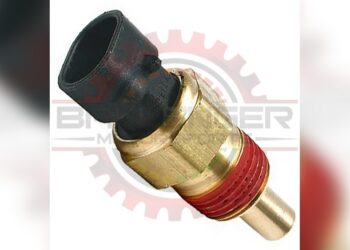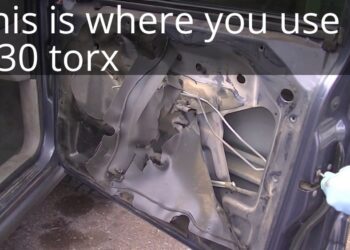If you’re dealing with rust on metal surfaces, you’ve probably come across two popular treatments: POR 15 and Ospho. Both promise to stop rust and protect your metal, but which one is right for your project?
Choosing the best rust treatment can make all the difference in how long your metal lasts and how good it looks after. You’ll discover how POR 15 and Ospho work, their key differences, and which one suits your needs best.
Keep reading to make sure your next rust repair is done right the first time.

Credit: www.reddit.com
Por 15 Features
Por 15 is a popular rust prevention coating known for its strong protection. It offers unique features that help protect metal surfaces from rust and corrosion. Understanding these features can help you choose the right product for your project.
Surface Preparation
Por 15 requires thorough surface preparation for best results. Remove loose rust, dirt, and grease using a wire brush or scraper. Clean the surface well to ensure good adhesion. Avoid sanding or grinding the metal after cleaning. The surface must be dry and free of contaminants before application.
Application Process
Apply Por 15 directly to bare metal or rusted areas. Use a brush or spray for even coverage. The coating is thick and dries to a hard finish. Avoid thinning the product, as it can reduce effectiveness. Allow each coat to dry fully before applying another. Usually, two coats provide strong protection.
Durability And Finish
Por 15 creates a tough, non-porous finish that resists moisture and chemicals. It is highly durable and protects metal for years. The finish is glossy and smooth, helping prevent future rust. Por 15 is resistant to chipping and cracking under stress. It maintains its protective qualities in harsh environments.
Aftercare Tips
After applying Por 15, avoid heavy impact or abrasion on the coated surface. Clean gently with mild soap and water if needed. Inspect the surface regularly for any damage or wear. Touch up any chips or scratches promptly to keep protection intact. Proper aftercare extends the life of the coating and the metal underneath.
Ospho Features
Ospho is a rust treatment solution designed to stop rust and prepare metal for painting. It converts rust into a stable, black protective surface. This makes it easier to paint over and protects metal from further corrosion.
Ospho works best on bare metal but can also be used on lightly painted surfaces. It helps increase the durability of paint and extends the life of metal objects.
Surface Cleaning
Start by removing all loose rust, dirt, oil, and grease. Use a wire brush or scraper to clear flaky rust and old paint. Clean the surface well for Ospho to work effectively. A clean surface ensures better rust conversion and paint adhesion.
Application Guidelines
Apply a thin coat of Ospho directly from the container. Use a brush or spray for even coverage on rusted areas. Avoid thick layers to prevent peeling. Ospho reacts with rust to form a protective layer quickly.
Drying And Curing
Let Ospho dry completely, usually in 30 to 60 minutes. A grayish-white powder may appear; brush this off gently. Wipe the surface with mineral spirits if needed. Full curing helps create a strong, protective barrier on the metal.
Painting Over Ospho
You can paint directly over dry Ospho. Oil-based paints work well with it. For better results, use a primer before painting, especially for automotive finishes. Test a small area first to check paint adhesion and compatibility with your paint system.
Performance Comparison
Comparing the performance of Por 15 and Ospho helps choose the right rust treatment. Both products target rust but work differently. Understanding their strengths guides the best use for metal protection.
Rust Treatment Effectiveness
Por 15 stops rust by sealing it under a tough coating. It creates a hard barrier that prevents moisture from reaching metal. Ospho converts rust into a stable surface using a chemical reaction. This process stops rust from spreading and prepares metal for paint. Por 15 works well on heavy rust but needs clean surfaces. Ospho suits light to moderate rust and cleans before use.
Adhesion And Compatibility
Por 15 bonds tightly with metal, forming a strong, durable layer. It does not need a primer but must be applied on rust-free, clean surfaces. Ospho acts as a rust converter and primer, allowing paint to stick better. Paints, especially oil-based ones, adhere well over Ospho-treated metal. Testing small areas ensures proper adhesion with specific paint types.
Resistance To Elements
Por 15 offers high resistance to water, chemicals, and weather damage. Its coating remains stable under harsh conditions for years. Ospho protects metal by stopping rust but requires a topcoat for full protection. Without paint or sealant, Ospho-treated surfaces can degrade faster outdoors. Por 15 is better for long-term exposure, while Ospho suits indoor or covered uses.
Usage Scenarios
Choosing between Por 15 and Ospho depends on the specific usage scenario. Both products offer rust protection but serve different purposes and surfaces. Understanding where each excels helps in selecting the right treatment for your project. Below are common situations where each product is best suited.
Bare Metal Applications
Ospho works well on bare metal surfaces. It treats rust by converting it into a stable compound. Apply Ospho after cleaning the metal thoroughly. It is ideal for preparing metal before painting. Por 15 also works on bare metal but forms a hard, protective coating. Por 15 creates a rust-proof barrier that stops future corrosion. Use Por 15 if you want a durable, long-lasting finish on bare metal.
Painted Surface Treatments
Ospho can be applied over painted surfaces if the paint is in good condition. It penetrates rust spots without damaging the paint. Por 15 is not recommended on painted surfaces because it requires direct contact with metal. For painted surfaces with rust, Ospho is the safer choice. After Ospho treatment, you can paint directly over it for extra protection.
Automotive Vs Agricultural Use
Por 15 is popular in automotive repair and restoration. It protects car frames, chassis, and parts exposed to moisture. Por 15 offers a tough finish that handles road wear and salt. Ospho suits agricultural equipment and tools. It prevents rust on farm machinery exposed to dirt and weather. Ospho is easier to apply in large areas and offers a good base for paint. Choose Por 15 for vehicles and Ospho for farm gear.
Cost And Availability
Cost and availability are key factors when choosing between POR 15 and Ospho rust treatments. Both products serve similar purposes but vary in price and ease of purchase. Understanding these differences helps you pick the best option for your project and budget.
Price Differences
POR 15 usually costs more than Ospho. Its price reflects the advanced formula and longer-lasting protection. Ospho is more affordable and suits smaller jobs or tight budgets. The cost gap can influence your choice based on project size and frequency of use.
Where To Buy
POR 15 is widely sold in automotive and hardware stores. Many online shops also stock it, making it easy to find. Ospho is often available at local hardware stores and some automotive suppliers. Online platforms offer Ospho too, sometimes at a lower price. Availability depends on your location but both are generally accessible.
Value For Money
POR 15 offers strong rust prevention that can save money on repairs. Its durability justifies the higher price for many users. Ospho provides good rust treatment at a lower cost. It works well for light to moderate rust issues. Choosing the right product depends on how much protection you need and your budget limits.

Credit: minda.by
User Tips
Understanding user tips helps you get the best results with Por 15 and Ospho. Both products require careful handling to protect metal surfaces effectively. Follow these simple tips to ensure proper application and long-lasting protection.
Surface Prep Best Practices
Start by removing loose rust, old paint, dirt, and grease. Use a wire brush or scraper to clean the surface thoroughly. Degrease the metal with a suitable cleaner for better adhesion. Make sure the metal is completely dry before applying either product. Proper surface preparation improves the treatment’s effectiveness and durability.
Painting Over Treated Areas
You can paint directly over dry Ospho without issues. Oil-based paints usually work well on treated areas. For extra durability, applying a primer is a good idea. Some paint systems require neutralizing Ospho before priming. Always test a small spot first to check paint adhesion. Por 15 creates a tough layer that many paints stick to easily.
Safety Precautions
Work in a well-ventilated area to avoid inhaling fumes. Wear gloves and eye protection when handling Por 15 or Ospho. Avoid skin contact; these products can cause irritation. Keep containers tightly closed when not in use. Store away from heat and open flames. Follow all label instructions for safe use.

Credit: www.youtube.com
Frequently Asked Questions
What’s Better Than Por-15?
Rust-Oleum Marine Coatings and Eastwood Rust Encapsulator offer strong alternatives to POR-15. They provide excellent rust protection and ease of use. Choose based on your project needs for better durability and application.
Can You Paint Directly Over Ospho?
Yes, you can paint directly over dry Ospho. Clean and dry the surface thoroughly before painting. Using a primer improves durability and adhesion. Test a small area first to ensure compatibility with your chosen paint system.
Can You Put Por-15 Directly Over Rust?
Do not apply POR-15 directly on loose rust. Remove loose rust, dirt, and grease first. Apply POR-15 only on clean, solid rust surfaces for best adhesion and protection.
Does Ospho Need To Be Rinsed Off?
No, OSPHO does not need to be rinsed off. Simply apply it thinly on clean, dry metal and allow it to dry before painting.
What Is The Main Difference Between Por 15 And Ospho?
POR 15 is a rust-preventive paint, while Ospho is a rust converter and metal prep solution.
Conclusion
Choosing between Por 15 and Ospho depends on your project needs. Por 15 offers strong rust protection and a durable finish. Ospho works well as a rust converter and primer base. Both require proper surface cleaning before use. Applying thin, even coats improves results.
Always let the product dry fully before painting. Testing on a small area ensures compatibility with your paint. Understanding these points helps you pick the right rust treatment for your metal surfaces.

















